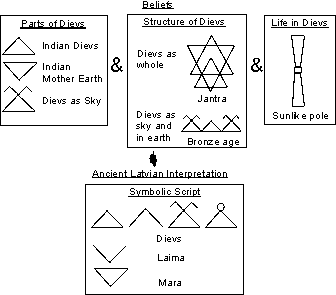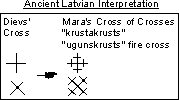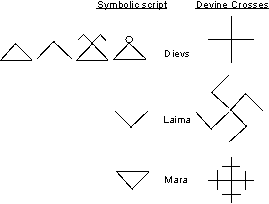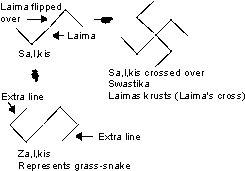Synthesis of Ancient Latvian philosophy
Gods and goddesses
In the dainas, trees are used as metaphors to explain natural processes while the saules koks (sun or life tree) is used to explain devine processes.
Another way to understand how the world works (i.e. Dievs) is through the pantheon of gods and goddeses. Dievs can appear in any form (dievi,ni - many tiny Dievs). For example, Dievs can appear on earth as a snake or in a field. Dievs can also appear as personified phenomenon - gods and goddesses.
Main devine trinity
The main devine parts of Dievs:
1) Laima (fate)
2) Māra (material earth)
This Devine trinity from the Indian Jantra, and corresponding Sauļotais stabs (sunlike pole)
Genesis of symbolic script and crosses
Genesis of symbolic script for main devine phenomenon
Genesis of Dievs' Cross
Genesis of Mara's Cross
Genesis of Laima's Cross
Summary of devine symbolic script and crosses of ancient Latvians
Devine triad of good versus bad
LATVIAN
 |
INDO-ARYAN
 |
LATVIAN
Laima is the part of Dievs which determines your fate. Laima actually means good luck. To increase your chance of good luck, she appears as Karta and Dekla.
Karta reminds us to respect all things female:
Mīļa Māra rītiņā
Treju durvju vizināja:
Pie govīm, pie aitām,
Pie jaunām meitiņām.
|
Dekla points out that the questionable character of men and all things male will ultimately determine the fate of Dievs:
Ko būs manin nu darīt
Dieviņšs teica, Dēkla liedza;
Dieviņšs teica maizes zemi,
Dekla slikta arājiņa.
|
So within the Latvian pantheon of gods and goddesses there is no battle between good and bad with
corresponding winners and losers. Karta and Dekla simply observed and pointed out the factors
influencing the fate (Laima) of Dievs.
INDIAN
In contrast, the Indian sacred triad is the classical fight between good and evil with a grand ruler.
Brahma
The creator and master of gods. |
Dievs
Does not rule. Represented through other gods and goddeses.
|
Vishnu
1) The preserver of god
2) The preserver of love |
Māra, Saules meitas
1) The preserver of god: Saules meitas (sun's daughters) and Māra nurture life and therefore Dievs
2) The preserver of love: love is nurtured, just like life, through the qualities defined in Māra (The essence of love, just as the essence of life, is not worshiped through a goddess, as that holds no practical purpose.)
|
Shiva
The destroyer |
Dievadēli
Are by no means destroyers. They can do incredibly good things, but can do bad things as well.
Their nature is questionable.
|
ZAĻĶIS -Link between heaven and earth
The grass-snake represents the link between heaven and earth. Its symbolic script is called Zaļķis.
Genesis of Zaļķis
- Beliefs
- 1) Native neolith: worshipped grass-snake
2) Indian Jantra: when dievs meets mother earth, get good luck (Laima)
- Ancient Latvian interpretation
- Grass-snake link between heaven/sky and earth.
Drawn with Laima's symbolic script. Considered part of Māra.
Implications
- Grass-snake considered part of Māra, but represents Laima
- Through the grass-snake Laima tells us of the importance of Māra and all things female. (This is the same message that the goddess Karta gives.)
- Artifacts
- Zaļķis symbolic script on women's cloths, therefore showing importance of female things.
- Dainas
- Melna odze ietecēja
Mana govju laidarā; (snake goes into cow pasture)
Tā nebija melna ozde, (that wasn't a snake)
Tā bij govju Māršaviņa. 32446 (that was Mārsava)
(i.e. Laima, represented as snake, tells us of importance of Māra who is represented by the cows - Mārsava)
Mārsava
- Belief
- Indian: cow worshiped
- Ancient Latvian interpretation
- The cow is a part of Māra with a special name "Mārsava". (Govju māte takes care of the cows.) Mārsava represents the importance of females for survival.
[Pantheon of gods and goddesses]
|







